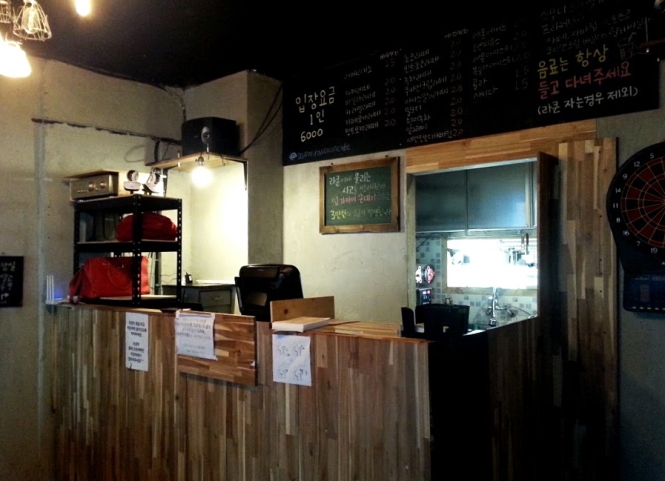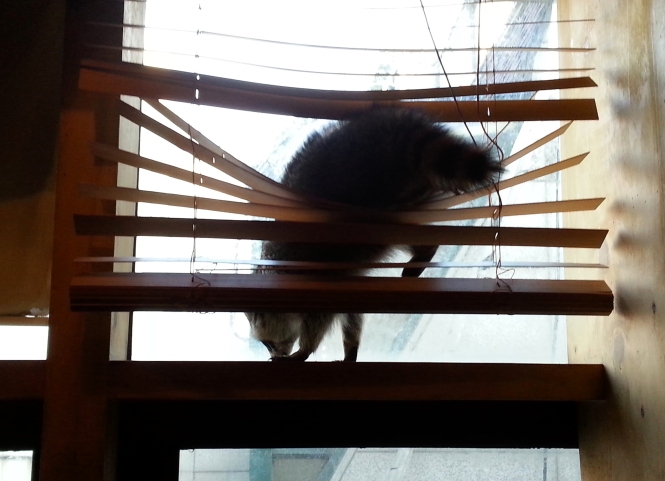Korea is known for a lot of its quirky cafes, with dog and cat cafes being the most common. For someone separated from their beautiful babies (puppies that is) by thousands of miles of ocean, dog and cat cafes are the best.


But in my experience, the quality varies wildly. In some places the cats shed a lot, making you wish you didn’t have to bother buying a drink. In some the animals are in a separate section. In others the animals just squat down and do their business wherever and whenever they want. In yet others, the dogs seem to be potty trained, although there’s always a risk. Some dogs are friendly, some are lazy. Some won’t hesitate to jump into your lap and some won’t come near unless you buy them treats.
But this post isn’t about dogs and cats – it’s about RACCOONS!
Yes, there are raccoon cafes in Korea. Yes, there is more than one. So there was some research involved to ensure we got a quality raccoon experience. I’ve only heard of them being in Seoul so far, so while briefly staying there this winter, Erin, Arria and I decided to finally go to a raccoon café.
Erin did her research well and we decided on Raccoon Café Kkukkune (라쿤카페꾸꾸네) in Hyehwa which had 6 raccoons, although it was a little pricier – a 6,000 won entry fee plus the cost of a drink. Here’s a pretty good review of the café, complete with directions and tons of pictures.
There are two other cafés that came up after a quick search. One was Blind Alley at Sookmyung, which has only two small pet raccoons kept in a separate area. If you’re going with someone not too keen on the idea of a raccoon café, this would be a good choice.
Finally, the last place that always popped up was Bonita di Café. The blog post I read on it (which I can’t seem to find anymore) went on and on about the cute raccoons (they mentioned there being 4), but only as an afterthought at the end did the author reveal that the place smelled really bad and that she left with the smell on her too. Sounds like a nope. The café is also mentioned in this article (rightfully) critiquing the use of animals in cafés. Based on descriptions, I wouldn’t recommend going here, but it looks like their business is still going strong.
There were a lot of notable differences at Kkukkune. Upon entering you remove your shoes and put on slippers – not unusual in Korea. As soon as I stepped inside, I saw two huge white raccoons eating from food bowls directly in front of me.

When you buy your required drink, you are also given a sheet of rules, including things like, don’t touch the raccoons when they’re sleeping, don’t feed them, and always watch your drink carefully. They had English copies of the rules for us, which although somewhat awkwardly-translated, were understandable. As the rules instructed, we placed our bags and coats in lockers, keeping only our phones for pictures.

There were lots of wooden cubbies, climbing posts and places for the raccoons to play, hide or sleep. There were cages as well, and another room that was off-limited to customers, but had more cubbies for the raccoons. It’s nice that they had a place to get away from people if they wanted it.



As were putting our belongings into lockers, one of the raccoons climbed onto Erin’s back when she leaned down. The café worker rushed over and kind of hissed angrily at it, making swatting motions towards its face until it backed off. Another one tried to climb up another girl’s leg, and unfortunately its claws tore a hole her pantyhose. Part of the hazards of a raccoon café, I guess, and that was the most contact we had with them our entire stay.
But you’re still waiting for raccoon pictures! Let me highlight a few characters.
First was Plank Raccoon, my first photography subject.

Erin, Arria and I sat down at our table, only to realize a little ways in that there was a raccoon above us. Our movements eventually piqued Plank Raccoon’s interest enough reveal more of its cute furry face.

There was Pensive Raccoon. (Credit for the name goes to Arria.)
It took a long nap inside of the cubbies – this might’ve been the same raccoon who tried to climb over Erin, but I can’t be sure. After its nap, Pensive Raccoon came out and reflected on life, basking in the spotlight it knew it was getting. Pensive Raccoon stayed there in its post-nap stupor (or deep reflection, I can’t say) for a long time.
Finally, the star of the show was Blinds Raccoon.

Blinds Raccoon was preoccupied with the blinds for the majority of our time there. It loved adventure and risk-taking, and wasn’t afraid to look silly.


Later, Blinds Raccoon got tired of the blinds and decided to climb into a cubby with its friend. The friend wasn’t so enthused about this chubby friend’s invasion of its space. But like a good friend, it put up with it.
But Blinds Raccoon soon realized that this wasn’t going to work. After testing the blinds a bit more, it decided on a nap and chose the highest cubby right next to our table. First Blinds Raccoon struggled to get comfortable.

A lot.
Finally, Blinds Raccoon went to sleep. Or tried too. But before settling in too deeply, Blinds Raccoon couldn’t resist a final pose for its adoring fans.














